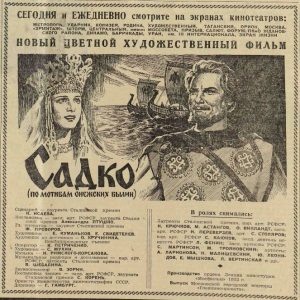
THE SCREEN IN REVIEW; ‘ Sadko,’ an Opulent Version of Rimsky-Korsakoff’s Opera, Is New Feature at the Stanley
H. H. T. June 1, 1953
For exotic imagery and shimmering grandeur, the Magicolor pageant the industrious Russians have fashioned from Rimsky-Korsakov’s opera, «Sadko,» would be hard to surpass.The Mosfilm transcription of a work best known here for «Song of India» in concert (and, lest we forget, swing) format marks that country’s boldest, most ambitious musical venture to date. As well-rounded entertainment, some spectators may prefer one of several tidier predecessors at the Stanley Theatre, the scene of Artkino’s classical field-day during the last eight months. But from a stand- point of size, decor, costumes and plain gumption, this time the Soviets really have rolled out the barrel.The opera itself, a fantasy-travelogue of the legendary seventeenth-century minstrel who roamed the world seeking a magical bird, is a natural for film cameras. And this adaptation, credited to K. Isayev, stresses the narrative, limiting the superb vocalizing to a reasonable quota of excerpts. A huge cast, headed by Serge Stolyarov, enacts an almost incredibly picturesque odyssey in imaginative, eye-popping settings, lushly underscored by the sound track, that alone are worth the admission price.These include the massive barbarism of the port of Novgorod on the jewel-like Lake Ilmen, a fabulous Indian walled city yielding a horde of Hindus, elephants and, in an evil maharajah’s palace, the reasured fowl and the azure iridescence of a jolly subterranean kingdom where the shipwrecked Sadko finds consolation with a decorative princess.However, with all due respect to the dazzling opulence, beauty waxes increasingly cumbersome. For one thing, while the hero originally craved personal wealth only to find the grass greener, this version allots him a heavy-handed obsession for enriching the home town masses. The florid, redundant oratory of these scenes, and indeed the erratic continuity in general are sorely needful of some shearing and lubrication by a battery of slick Hollywood technicians.Furthermore, Director Alexander Ptushko keeps his actors, particularly the handsome Mr. Stolyarov, literally shouting and gesticulating to beat the band, on the same expansive scale as the backgrounds, with few lighter shadings of fairytale intimacy.The ethereal nub of the text, when the gorgeous head of the captive phoenix (attributed to a lady named L. Vertinskaya), perched beneath an exquisitely tinted dome, hypnotizes the hero with her common-sensical murmuring about man’s eternal quest for happiness, barely misses being farcical.Although neither the trimmest nor the most persuasive of the current Soviet musical parade, «Sadko» remains, nevertheless, truly a sight for anybody’s tired or rested eyes.
SADKO, scenario by K. Isayev, based on the opera by Rimsky-Korsakov; directed by Alexander Ptushko, with sets by E. Kumankov and E. Svidetelev, and distributed by Artkino Pictures, Inc. At the Stanley 31 May 1953 (New York City, New York).
Sadko . . . . . Serge Stolyarov
Lyubava . . . . . Alla Larionova
Trifon . . . . . N. Troyanofsky
Vyshata . . . . . N. Malishevsky
Ivashka . . . . . B. Surovtsev
Kuzma . . . . . Y. Leonidov
Maharajah . . . . . L. Fenin
Leader of the Varangians . . . . . M. Astangov
Tsar of the ocean . . . . . S. Kayukov
Tsarina . . . . . O. Vikland
Princess Ilmen . . . . . E. Myshkova
The Phoenix . . . . . L. Vertinskaya
«Садко» Выпущен на экран в СССР 5 января 1953 года.
| ФИЛЬМОГРАФИЯ ОТЕЧЕСТВЕННЫХ ФИЛЬМОВ |



